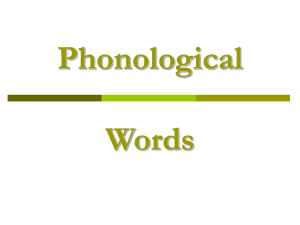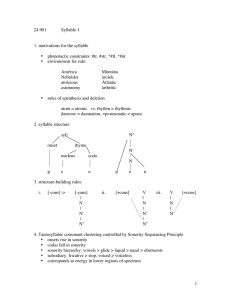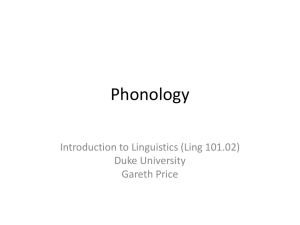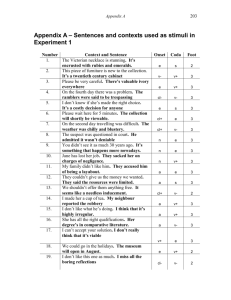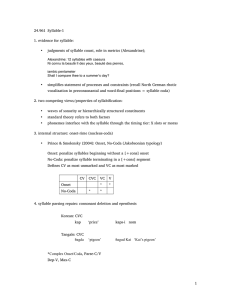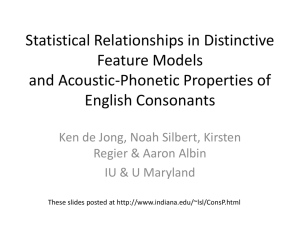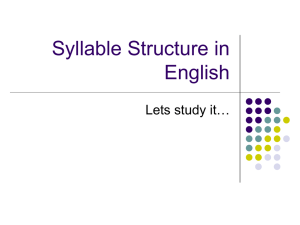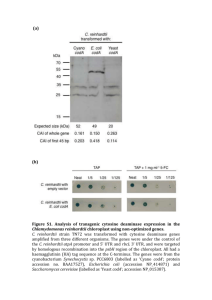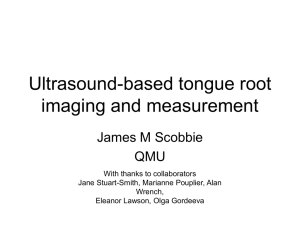20130928163055581260
advertisement
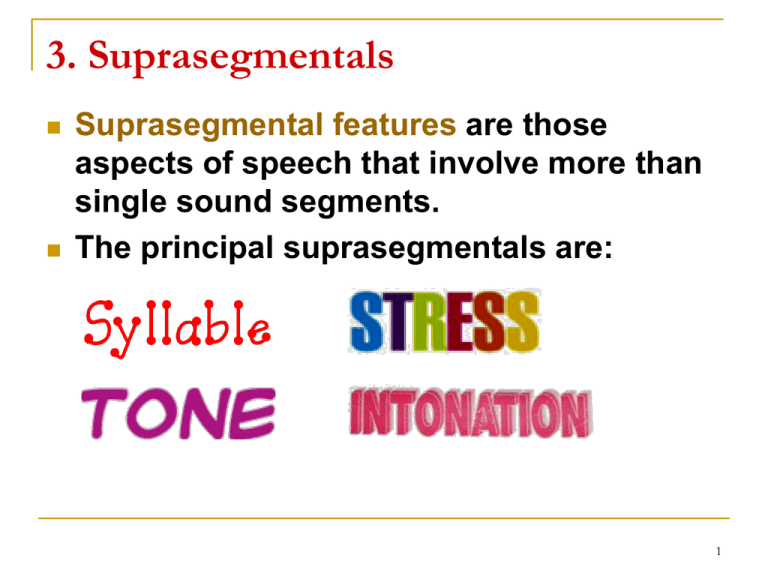
3. Suprasegmentals Suprasegmental features are those aspects of speech that involve more than single sound segments. The principal suprasegmentals are: 1 3.1 The syllable structure σ Onset Rime Nucleus k r æ Coda k t 2 Open syllable: bar, tie Closed syllable: bard, tied English Syllable: (((C)C)C)V((((C)C)C)C) Chinese syllable: (C)V(C) 3 Maximal Onset Principle (MOP) When there is a choice as to where to place a consonant, it is put into the onset rather than the coda. Cf. tell and telling – resyllabification te- + -lling 4 Resyllabification bottle bottler, call calling, cool cooler, deal dealer/dealing, fall falling, fell felling, feel feeling, fool fooling, football footballer, full fully, girl girlish, howl howling, jell jelly, kill killer/killing, mail mailing, pull puling, roll roller, seal sealing, sell selling, whale whaling/whaler, whole wholly, yell yelling, … 5 Sonority scale It is interesting to find that in English consonant clusters in onset and coda positions disallow many consonant combinations. For example, we can have help, lump, pray, and quick, but not *hepl, *lupm, *rpay, or *wqick. It is found that a sonority scale is at work. The degree of sonority of different classes of sound affects their possible positions in the syllable: 6 Sonority scale: Most sonorous Least sonorous 5 4 3 2 1 Vowels Approximants Nasals Fricatives Stops 7 8 In a word such as cracked, the sonority of each sound gradually rises to a peak at the nucleus and then falls at the coda: 5 4 3 2 1 * k * * * r æ k * t 9 This explains why *rkatk is not allowed: 5 4 * 3 2 1 r * * * k æ * t k 10 Problems with the sonority scale Consider the case of silk and sickle. They consist of the same sounds, but are arranged in a different order. Whereas silk follows the correct sequence of the sonority scale, sickle does not. The traditional practice is to take sickle as a disyllabic word so that [kl] forms a syllable of its own, with [l] being considered to be syllabic. 11 The case with [s] in the onset position also behaves unusually, in that it can combine with almost any onset to form a cluster of up to three consonants, e.g. [spl-], [spr-], [str-], [skw-]. Two views have been found to explain this. One is to take [s] as a separate syllable, i.e. to treat words like stock as disyllabic, but this is however against most native speakers’ intuition. Another view is to take such a segment as an “appendix”. 12 Phonotactics The rules that describe possible sequences of sounds for forming English words. Language can differ in their phonotactic rules, so that mbotto might be a possible word of Swahili, or psore a possible word of Greek, but they are not possible words in English. 13 Phonotactic rule 1: Sequences of repeated consonants are not possible. /sssitttt/ As the snake slid swiftly past him, Harry could have sworn a low, hissing voice said, ‘Brazil, here I come…Thanksss, amigo.’ 14 Phonotactic rule 2: The glottal fricative /h/ never occurs in the coda of a syllable. This rules out the possibility of beh. 15 To rule out flezk and zipb Other coda rules: If the second consonant in a complex coda is voiced, the first consonant in the coda must also be voiced. When a non-alveolar nasal is in a coda together with a non-alveolar obstruent, they must have the same place of articulation, and the obstruent must be a voiceless stop. Two obstruents in a coda together must have the same voicing. 16 To rule out psore and mbotto Basic onset rules: /ŋ/ is not a possible onset. Complex onsets may not contain affricates or /h/. Two-consonant complex onsets may contain either: A. first consonant: any obstruent other than /s/; second consonant: liquid or glide (l,r,j,w). B. first consonant: /s/; second consonant: nasal, liquid, glide or voiceless obstruent (except //). 17
